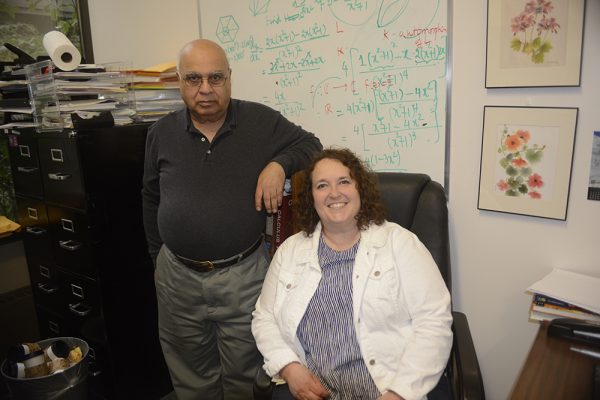UAA professors grew a marriage out of math
by Tracy Kalytiak |

Kamal and Deborah Narang work as math professors at UAA. (Photo by Tracy Kalytiak / University of Alaska Anchorage)
One morning, a young graduate student at Ohio State University approached an older graduate student and asked him for help with a number theory problem.
Deborah Haas and Kamal Narang weren't strangers-the two ate together as part of a group of math students in the commons-but otherwise, they were just friends, so she was shocked by what he said to her.
"He asked me to marry him," Deborah said. "He'd never even shaken my hand." Then she joked, "He was unclear on the concept of dating."
Thirty-three years and 3,930 miles away from that awkward beginning, Deborah and Kamal Narang are working as UAA math professors and nearing their 31st wedding anniversary. And their daughter, Maya, is a UAA journalism student.
Growing a life-and love-in math
Kamal hails from Allahabad, a city of 2 million people situated along the Ganges River in northcentral India. Kamal did not get to choose his own path in school-the Indian educational system decided what he would study.
"You used to be more or less on a 'track' when you finish eighth grade," he said. "I had taken the science track-physics, chemistry, mathematics. Once you finish ninth, 10th, grade, there's no way to change."
Kamal discovered in his teens that he had a talent for math.
"When you're in high school, you have to be addicted to something," he said. "I was addicted to trigonometry. It just clicked. Ninth-graders came to me to explain and we just sat outside on the stairs. That's what made me decide I was going to teach for the rest of my life. Mathematics doesn't require labs, just a chalkboard."
Kamal graduated from Allahabad University and earned his master's degree at the Indian Institute of Technology in Kanpur. He then went to Bombay University on a government fellowship. An advisor told him of an opportunity to work as a teaching assistant in the United States, but Kamal's fellowship ran out before that job became available. He needed to find a way to make money, immediately.
Deborah grew up near Ohio State, in Westerville, Ohio. Her father worked as a high school math teacher, so numbers entered her life at a very early age.
"He had the math books at home, would bring home puzzles," she said. "I wanted to be a teacher."
Deborah eagerly explored French, chemistry, computer science and physics, and liked almost every course she took.
She earned her bachelor's degree in math-summa cum laude-from Capital University in Columbus, Ohio, and a master's degree in math from OSU in 1985. (She earned her Ph.D. in math in 1994, from the University of New Hampshire.)
"I loved college, I loved school. But my major was math, always," she said. "I was kind of lazy and didn't want to write papers and do labs."
Why math?
"Math really is a search for structure, it's a search for commonalities, there's kind of a rhythm to math, in a way," she said. "Right now you look at politics and how divisive it is. When you look at math, you look at different objects and say, what's the same about these, and once I know what's the same, what can I say about that sameness? And that I just find really...pretty."
Finding harmony
By 1985, Deborah and Kamal knew each other well. Deborah was the kind of person who, when OSU sent her two parking passes, returned one of them even though her friend urged her to sell it.
"She was exceedingly honest," he said. "That made a huge impression. And she said, if I really wanted money, why would I go into teaching math? That hit the right place inside me."
Deborah originally thought Kamal was "a little weird."
"He always looked sad," she said. "After I got to know him I heard a lot of stories. He used to play pranks in India, like lowering a goat over a transom into one of his friends' rooms. That's definitely not the work of a sad person!"
"It was a dog," Kamal countered, breaking into a rare smile. "Why didn't I think of a goat? Goats are easier-goats don't bite!"
Their courtship proceeded sedately. "We'd go out for dinner once in a while, order what we could afford-not much," Kamal said.
He proposed that fall. That Thanksgiving, he and others they knew were eating a holiday dinner and Deborah's Jello salad at her parents' home.
"It all slowly and slowly...the pieces just started fitting," Kamal said. "It became more understood than said."
The two married in Columbus in 1985, two years after he had proposed-she wore a traditional American-style white dress, he wore Indian clothes instead of a tuxedo. They celebrated at a reception in India a year later.
Kamal acknowledged he had reasons for feeling sad, back when he first met Deborah.
"That was one of the reasons why I started more and more feeling that I wanted to be with her," he said. "She cured all that...she took me out of that."
Written by Tracy Kalytiak, UAA Office of University Advancement
 "UAA professors grew a marriage out of math" is licensed under a Creative Commons Attribution-NonCommercial 4.0 International License.
"UAA professors grew a marriage out of math" is licensed under a Creative Commons Attribution-NonCommercial 4.0 International License.














